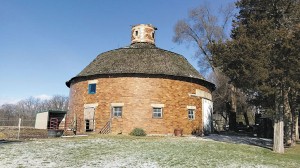INDIANAPOLIS — Indiana Landmarks has announced the 10 Most Endangered, an annual list of Hoosier landmarks in jeopardy. The list includes a courthouse, municipal, commercial, community and school buildings, houses, and barns that share an unusual characteristic.
“These places shape lives and give identity to communities, and when they’re gone, they leave a void that can’t be filled,” says Marsh Davis, president of the nonprofit preservation organization. “While some might call these lost causes, we can point to countless 10 Most success stories — places on the brink of extinction that were saved, restored, and repurposed,” he adds.
Demolition has claimed only 16 of the 119 Most Endangered sites listed since 1991, while 72 places are completely restored or no longer endangered.
The 10 Most Endangered in 2017 includes three sites repeating from last year’s list and six new entries (see addendum for more information on each): Washington County Courthouse, Salem; Speakman House, Rising Sun; Pryor’s Country Place, Fox Lake.
One entry on the 2017 list returns to the list after a long absence: Simpson Hall, Indiana School for Deaf, Indianapolis.
Six sites appear on the 10 Most for the first time: Old Fire Station 18, Indianapolis; Old Marquette School, South Bend; Marion National Bank Building, Marion; Old YMCA, Terre Haute; Newkirk Mansion, Connersville; Round and polygonal barns, statewide.
The two Indianapolis structures on the list are places of historic significance. Simpson Hall is one of the five surviving National Register-listed buildings in Rubush and Hunter’s original Neoclassical quadrangle-style campus. The 1911 building has been vacant for more than 30 years without maintenance and urgently needs stabilization. The legislature has appropriated nearly $1 million to demolish the structure. Located at 1200 E. 42nd St., immediately north of Indiana State Fairgrounds, Simpson Hall overlooks the popular Monon Trail.
Old Fire Station 18 at 3130 W. Washington St., was designed by Pierre & Wright, and built in 1936 at the edge of the former Central State Hospital. IFD replaced the Art Deco-style station in 1994 and it has been vacant, neglected, and graffiti-tagged ever since. The station’s design has been praised for its functional modernism and compact layout. If the building is allowed to deteriorate further, it may not be recoverable.
Places that land on the 10 Most Endangered often face a combination of problems rather than a single threat — abandonment, neglect, dilapidation, obsolete use, unreasonable above-market asking price, owners who simply lack money for repairs, remote location — or its opposite, encroaching sprawl that makes the land more valuable without the landmark.
To find out more about each of the 10 Most Endangered, visit www.indianalandmarks.org or contact Indiana Landmarks, 317-639-4534 or 800-450-4534.



